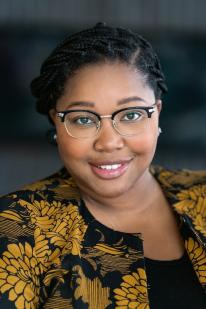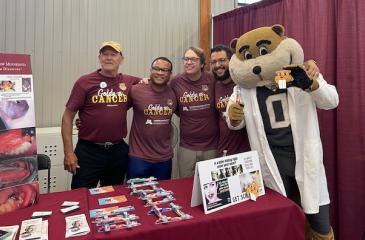Why community matters in cancer research
The Masonic Cancer Center, University of Minnesota (MCC) has been around for over 30 years, focused on one mission: reducing the burden of cancer on Minnesotans. Every day, our doctors, scientists, and educators step into laboratories, college and high school classrooms, boardrooms, conference venues, and exam rooms to continue advancing knowledge and enhancing care for people who have been diagnosed with cancer, those undergoing treatment, those who are interested in cancer prevention methods, cancer survivors who no longer need treatment, and loved ones of people on a cancer journey.
We talk a lot about the research that helps drive our cancer center's work. But that research is only one piece of the puzzle, and it can only get us so far. It is equally important to make sure that everyone in our communities knows the latest developments in cancer research and care and can deploy them in their own lives and in the lives of loved ones. That’s where MCC’s Office of Community Outreach and Engagement—who we often refer to as our COE team—comes into play.
We sat down with Kiara, Rebekah, and Jen, who lead our COE team, to discuss the role community outreach plays in cancer research and care. Let’s hear what they had to say!
What is the mission and purpose of the COE team?
The COE team works directly with communities across Minnesota to: mobilize research that reduces the cancer burden; improve wellbeing and health for all; and provide access to knowledge and information about cancer prevention, treatment, survivorship, and clinical research opportunities. Many times, the COE team is the first connection community members have with the cancer center and the work we do.
Whether it’s meeting diverse communities where they’re at and in terms that make sense, building and maintaining relationships with community partners to host programs, supporting patients through the Cancer Information Nurseline and providing information on clinical trials, or engaging the community through conferences and events—like Goldy vs. Cancer, Fireside Chats, and the Cancer Survivorship Conference—the COE team is committed to showing up and being a valuable ally to Minnesotans.

“Community outreach and engagement are the bridge between our research and our community,” says Kiara Ellis, director of community outreach and engagement. “We provide insight and input to the community on the research happening across the cancer center.”
Serving as this bridge is of the utmost importance—after all, “It’s people in our communities who are experiencing cancer and the challenges around it,” says Rebekah Pratt, associate co-director for community outreach and engagement. Community members’ lived experiences can help inform and direct new clinical studies, therapies, and, more generally, how the cancer center shows up in cities and towns across Minnesota.
“Community members have many things to tell us and to guide us about how to address these issues and how cancer is impacting their lives and their communities,” Rebekah says. “That’s why it’s so important for us to open a dialogue between researchers and community members so that an exchange of information can happen, with insight and knowledge being shared in both directions.”
“We exist to serve all community members—to make sure that everyone who calls Minnesota home has access to top-notch care,” says Jen Poynter, associate co-director for community outreach and engagement. “Often, that means we have to take a close and hard look at which barriers we need to address or break down so that everyone in Minnesota can benefit from the work that we do here at the cancer center.”
Kiara adds: “MCC’s catchment area—the technical term for the area we serve—is specifically recorded as the entire state of Minnesota. That means we have to have all the voices of Minnesota at the table and make sure that we’re listening to those voices. We hope for the cancer center to be of service to our community and for people to have opportunities to engage with us beyond the research MCC undertakes and the care that our clinical partner, M Health Fairview, provides.”
Why is community outreach so important, especially in cancer care?
In any field of study, data plays an important role. Statistics and facts on how cancer shows up across Minnesota are paramount in determining priorities for medical professionals, for lawmakers, and for the groups that generously fund studies on issues facing Minnesotans. But it can be a challenge to keep sight of specific communities, particularly those who have often been medically underserved, when you’re looking at huge collections of data that have broad implications.

Rebekah explains it like this: “When we think about cancer research and what we know about Minnesotans and their experience of cancer, we’re often looking at really big datasets. It can be hard to find the nuance for what is happening in specific communities within that data. But, if we have relationships with those communities,” she notes, “the communities themselves can tell us exactly what their experiences are. And that can be genuinely life-saving, to hear directly from the source(s) how we can provide the best support possible, whether that’s by increasing prevention education and preventative care or by ensuring a community has improved access to cancer screenings.”
What’s more, research has a tendency to drive policy—and policy affects everyone on a day-to-day basis.
“When we learn that, for example, we need to start screening women for breast cancer earlier in life, or that we need to have different guidelines for the impact of screening on certain populations,” Kiara says, “having a connection with the community helps us make informed policies that have those communities in mind, especially those who are in the most need.”
From another perspective, community input brings an air of positivity to research, Rebekah adds. “Research tends to talk about deficits and risks and how we’re going to respond to problems,” she says. “But communities have lots of strengths and assets that researchers need to keep in mind—and researchers in general have historically not been great at remembering that. Communities bring tons of strengths to the problem-oriented approach that we often come from in research. So it’s critical that we involve them and partner together.”
When asked which communities receive priority consideration from MCC for outreach and engagement work, Rebekah notes that it’s a lengthy process to identify those groups. “We collect data from all sources, work with community partners and community members, and collaborate with our Community Impact Board to identify priority groups. It’s an ever-evolving process, but, in particular, indigenous and immigrant communities stand out, alongside people with cancer types that are more common among Minnesotans than people in other states."
Who does the COE team partner with?
From MCC’s Community Impact Board to the Minnesota Department of Health, elected officials, community organizations, and Minnesotans of all stripes, collaboration is the bedrock upon which the COE team rests. “We have so many valued partner organizations and groups from across the state,” says Jen. “Among those groups, our Community Impact Board is an absolutely crucial, key partner in actively providing insight, feedback, and accountability.”

The Community Impact Board (CIB) is a critical piece of our outreach and engagement functions and exists to incorporate the perspectives of Minnesota’s diverse communities in the planning, implementation, evaluation, and dissemination of activities of the Masonic Cancer Center, including research, clinical care, and outreach and education. The CIB works to enhance the relationship between MCC and our constituents, as well as help plan the future of the cancer center and articulate how we can grow and change to better serve all Minnesotans. Learn more about the Community Impact Board and current members. Interested in joining the Community Impact Board, or know someone who might be? Reach out to the COE team for more details.
From the Community Impact Board to far beyond, “We don’t limit our partners to those exclusively in the Twin Cities,” Rebekah says. “We work with other health systems, organizations, and people across the state to improve health and wellbeing for all Minnesotans.”
Kiara adds, “There’s always an invitation for organizations or people to engage with us. We work really hard to earn your trust and to build rapport with so many different people; it’s crucial that people see there’s so much more than just knowing what we’re researching that you gain from being connected to an academic system like the cancer center. We exist to help Minnesotans make the most informed choices about their overall wellbeing and healthcare and to equip community members with information so that they feel empowered to make those choices for themselves.”
At the end of the day, the COE team wants to ensure that everyone who calls Minnesota home knows their door is always open and the porch light is always on. “People should think of the cancer center as a place they can go, a resource where they can turn to access information on whole-of-life cancer care and support,” says Kiara.
Stay tuned for more from us in the coming months to be introduced to the team members you’ll see at events and learn how you can interact with us in your community! The best way to stay connected with the COE team is to sign up for our once-monthly “Community Matters” email newsletter, which has all the latest cancer resources, programs, and events.
